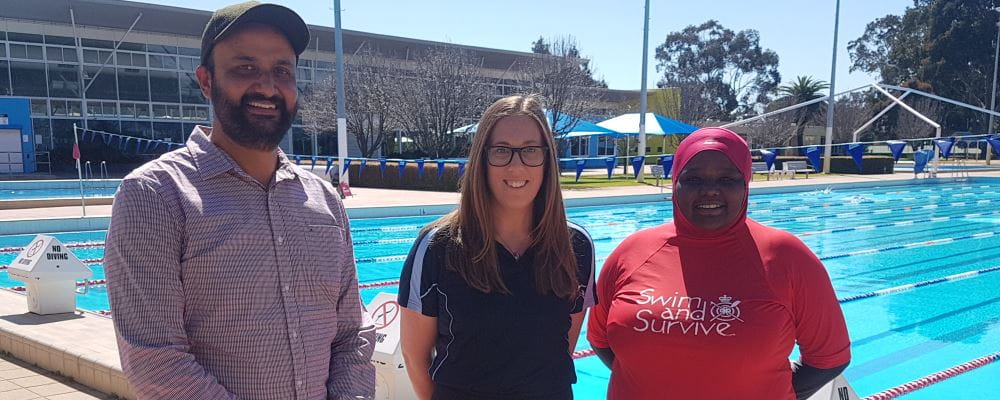
Jasjit Mann from Indian Society WA with RLSSWA's Lauren Nimmo and swim instructor Najma Ahmed by the pool at Terry Tyzack Aquatic Centre
WA migrant communities at high risk of drowning
Royal Life Saving Society is highlighting the importance of learning swimming and water safety skills for everyone across Western Australia, but especially those from multicultural communities, after new data revealed that 762 drowning deaths across Australia over the past 10 years involved people who were born overseas, including 137 in WA.
Of the drowning deaths that occurred in WA over the past 10 years, 40% involved people who were born overseas, the largest proportion of any state or territory. Males accounted for 83% of drowning deaths and 29% were aged between 18 and 34 years.
Lauren Nimmo from the Royal Life Saving Society WA says “Australia is a diverse nation and Western Australia is one of the most diverse states and territories with almost one third of our population born overseas and more than half having at least one parent born overseas. The fact that WA has the highest proportion of drowning deaths involving people born overseas nationally is extremely concerning.” Overall, the report highlighted that 43% of drowning deaths involved people who had been living in Australia for 10 years or more. However, 15% had recently migrated to Western Australia, with India, Ireland, Malaysia and the UK the most common places of birth.
Jasjit Mann is a prominent member of the Indian Society in WA and knows too well the impact that drowning has had on his community “all too often I hear the tragic story of someone who has lost their life to drowning from my community due to a lack of water safety awareness and swimming skills. Ensuring that everyone has the opportunity to learn vital swimming and water safety skills is so important, particularly for those having newly arrived in WA, to prevent these deaths.”
Beaches were the leading location for these drownings, accounting for 27%, followed by an ocean/harbour at 20%. Drowning most frequently happened while people when swimming & recreating, followed by rock fishing, while the risk factors identified included having a lack of appropriate swimming skills, being under the influence of alcohol and drugs, and having a pre-existing medical condition.
Lauren Nimmo says “The reality is that in many countries swimming and water safety education is not seen as a priority and is simply not accessible. Many migrants come to Australia unaware of drowning risks and don’t have the same level of experience when it comes to water safety that we as Western Australians often take for granted. Migrants also record lower participation in swimming and water safety programs after arriving in Australia due to a number of cultural, personal and financial reasons. Royal Life Saving WA has developed a range of initiatives to breakdown these barriers and ensure that everyone can enjoy these programs and gain valuable swimming and water safety skills. However, this report highlights that more needs to be done to address the issue of drowning in our migrant communities.”
Najma Ahmed is one of Royal Life Saving WA’s community ambassadors, who is passionate about promoting the benefits of learning swimming and water safety skills at any age. “When I came to Australia 15 years ago I had quite a lot of fear about the water and swimming, like many others from my community. I believe it’s important for everyone to have some knowledge about swimming and water safety, because once you have that, your fear somewhat subsides and you’re able to help yourself and others in the water. That lack of knowledge of what to do if you get into trouble is what leads to a lot of tragedy”.
As Royal Life Saving WA's Principal Community Partner BHP supports our swimming and water safety programs for at-risk communities through our Swim and Survive Access and Equity Program. Chris Cottier, BHP's Manager WA Communities says “Water recreation is a big part of the Western Australian lifestyle and water safety is an important safety issue in regional and remote areas. Our partnership with Royal Life Saving Society aims to improve the accessibility of water safety programs and include more members of the community in swimming education, so that our communities become safer places to live and work.”
To stay safe around water Royal Life Saving urges all Australians to follow these simple tips:
- Supervise children at all times around water
- Learn swimming and lifesaving skills (including CPR and rescue skills)
- Avoid alcohol around the water
- Never swim alone
- Be aware of limitations of swimming skills and fitness
- Be aware of medical conditions and the side effects of medication when around water
You can read the full report on drowning in Australians born overseas at the link below.
